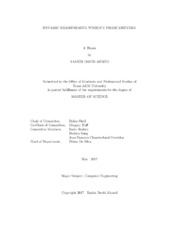| dc.description.abstract | Array beamforming is a widely-used technique for producing a flexible, retargetable, and tunable beam using fixed-position transmitting or receiving elements. It is well-understood, and widely used. Distributed and collaborative versions of the problem – where elements do not have fixed locations known ahead of time, elements may move, or elements may need to cooperate without central control – offer the benefits of beamforming in a much wider set of scenarios. The greater complexity introduced by the required coordination and estimation have limited its use in deployed systems.
One of the common assumptions of existing distributed beamforming techniques is that each element can use a phase shifter to alter its intrinsic transmit phase to an optimal value (measured, for closed loop strategies; calculated, for open-loop strategies) that minimizes inter-element interference in the main beam. In this thesis, I present a simple alternative method for minimizing interference: elements should deactivate their transmitter if their intrinsic phase is too distant from their optimal phase.
Omitting the phase shifter permits cheaper elements, but requires overprovisioning the number of elements in the beamforming system. In systems that have many elements a priori (a multirobot swarm, for example), this deactivation strategy can add beamforming capability at a lower cost.
I analyze the general behavior of a beamforming system built using this principle, discuss the tradeoff between allowable phase error and power in the main beam, and prove a lower bound on fraction of active elements in a transmitter swarm. In addition, I present simulation and benchtop results that illustrate the feasibility of element deactivation as a beamforming technique. | en |


